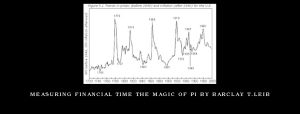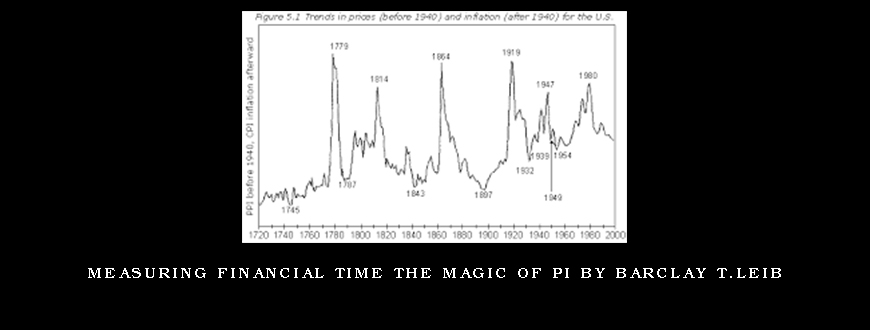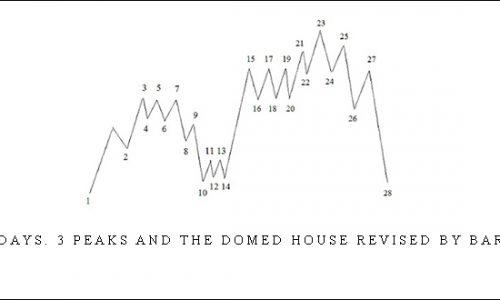
Measuring Financial Time The Magic of Pi by Barclay T.Leib
“This analysis originally appeared Feb 25, 2001 on Sandspring.com. It is a long term look at cyclical equity market rhythms, but now four months old, it is also slightly dated in parts. Specifically, when Mr. Leib’s $294.50 Fibonacci gold target mentioned in the article was reached, he advised to book profits and turned short-term neutral gold.”
In a recent book Stock Cycles (Writers Club Press, iUniverse.com, 2000) Michael Alexander does an admirable job debunking the notion that the “the best time to buy stocks is always now because stocks in the long run always go up.” Starting with statistical history, he shows that given the valuation levels at the beginning of 2000, “there is a 75% chance of negative capital gains return over the next 20 years,” and a “zero percent chance of the S&P 500 returning even 15% over the next five years.”
Also Get Measuring Financial Time The Magic of Pi by Barclay T.Leib on Traderknow.com
Given the recent drubbing of the S&P 500, Alexander looks to have been singularly prescient. It’s too bad book publishers take so long to put good copy into final bound form.
In the language of a true academic, Alexander goes on to divide equity market behavior itself into two cycles – a “monetary” one and a “real” one — that can take four basic permutations:
1) High inflation, high real earnings
– generally sideways periods of market chop
2) Low inflation, high real earnings
– periods of market boom
3) Low inflation, low real earnings
– periods of deflation/depression and booming bond markets
4) High inflation, low real earnings
– stagflationary periods of equity market
Also Get Measuring Financial Time The Magic of Pi by Barclay T.Leib on Traderknow.com
Hence, while earnings growth in the U.S. was effectively the same in the seventeen year period between 1965 and 1982 as it was between 1982 and 1999, Alexander blames the sideways performance of equities during the first of these periods on a negative inflationary monetary environment. Conversely, markets boomed in the latter period because of a better monetary environment.
Similarly Alexander compares the periods of 1929-1948 with that of 1948-1965. Here he finds that monetary conditions were similar in both periods, but the real earnings in the two periods were dramatically different. In the first period, real earnings were low together with low inflation, yielding a bull market in bonds rather than stocks. In the latter period, low inflation combined with high real earnings yielding a strong bull market once again.
Also Get Measuring Financial Time The Magic of Pi by Barclay T.Leib on Traderknow.com
Now all this is fine and good, but what Alexander seems to miss is the obvious periodicity of these periods: each is effectively 17 years in length. He does mention that the troughs between U.S. inflationary periods tend to be spaced an average of 51 years (interestingly, 3 x 17 years), and he shows this nice long term chart of U.S. price trends:
Source: Stock Cycles by Michael Alexander
Note that if the average 51-year inflationary trough tendency continues, 1949 + 51 years = 2000, so inflationary trends should already be on the upswing — as they are. At best this means that equities are in for a repeat of a 1965-1982 type chop performance as inflation starts to buffet any earnings growth. At worst it means that if earnings growth independently starts to decline (as the newspapers have been reporting daily of late), a stagflationary collapse is possible.
Also Get Measuring Financial Time The Magic of Pi by Barclay T.Leib on Traderknow.com
But let’s take a closer look at this 17-year cycle Alexander so adroitly discusses, but then fails to expand upon. More precisely, we believe it is actually a 17.2-year cycle. Why 17.2 years? Well, here we must start with the work of Martin Armstrong who, by measuring the average distance between market panics through the 19th and 20th centuries, believed that he had discovered a cycle he referred to as the Princeton Economic Confidence Interval of 8.6 years. He believed that multiple 8.6 year cycles in the markets existed that build in intensity to form a long-wave of economic activity measuring 51.6 years.
Now 8.6 years happens to equate to 3,141 days which is pretty damn close to the mathematical value of pi (3.14159) times a thousand. Twice pi times 1000 is 6,283 days or 17.2 years.
Ever remember the equation from your grade school days:
2 * * r = the circumference of a circle
Well, assume r, or the radius, is equal to a base unit of 1. This equation would then reduce to just 2 * , or in our thought process, the circumference of a circle equating to the completion of one full cycle. Pretty neat, eh? After all, if concepts like calculating the circumference of a circle hold in the physical world of geometry, why shouldn’t they hold in the financial world of Wall Street?
Also Get Measuring Financial Time The Magic of Pi by Barclay T.Leib on Traderknow.com
This leads us to the following hypothesis:
While the magnitude of up and down price fluctuations in equity markets are clearly governed by the rules of the Fibonacci Golden Ratio .618 (and its reciprocal 1.618) as derived from the Fibonacci Number Sequence 1,1,2,3,5,8,13,21…., the duration of economic cycles is governed not as much by Fibonacci, but by the cycle 2 * .
What anecdotal evidence helps us believe in the importance of 2 * ?
In 1720 we had perhaps the most famous panic of all time: the South Sea Bubble. Prior to that event, the biggest financial crisis came in the year 1092 when the practice of debasing the precious metal content of currencies returned for the first time since the fall of the Roman Empire, and interest rates surged to over 50% per annum in Britain. The difference in years between these two events just happens to be equal to 2 * * 100 = 628 years. Strange coincidence, no?
628 years prior to that event lands us in 464 AD when the Vandals were actually overrunning the Roman Empire, and the Anguls were invading Britain. The Roman currency was in the process of serious debasement at that time – in short, another financial panic.
Also Get Measuring Financial Time The Magic of Pi by Barclay T.Leib on Traderknow.com
Bringing our long-term analysis into the modern United States spectrum, if one measures the days between the founding of our nation on July 4, 1776 with the Declaration of Independence and the 2000 high in U.S. equities, exactly thirteen 17.2 year periods transpired as of February 23, 2000 — a date that fell almost perfectly between the January 2000 high in the Dow Jones Industrials and the late March high in the NASDAQ and S&P 500.
Coincidence again? Perhaps. But let’s take a look at the intervening thirteen 17.2-year cycles, subdividing them into their twenty-six 8.6 year half cycles, and focusing very much on the rhythm of inflation during each half-cycle versus stock prices. As we do so, we are going to try to assign each cycle an “Alexander classification.”
We start from July 4, 1776 onward not just because 1776 represents our nation’s birth, but also because 1776 comes exactly five 17.2-year cycles (86 years) after the first paper money experiment in the U.S. took place in 1690. It was in that earlier year of 1690 that the Massachusetts Bay Colony paid for a military expedition to Canada during King William’s War with paper money referred to as Bills of Credit. Hence we do not think our choice to examine the rhythm of modern times from July 4, 1776 onwards to be necessarily flawed in its arbitrariness.
Once we describe all the individual 8.6 year half-cycles within the 17.2 year overall cycles, we will try to glean a pattern of behavior within it all. So please bear with our bit of historical work for the moment.
Also Get Measuring Financial Time The Magic of Pi by Barclay T.Leib on Traderknow.com
First 17.2 Year Cycle
July 4, 1776 – Feb. 8, 1785: War, inflation, and counterfeiting marked the early part of this period. In 1778 four Continental Congress dollars equaled one gold dollar. A year later the ratio was 100-1. We shall call this an Alexander type 4 high inflation/low real earnings period to start us off.
Feb 8, 1785 – Sep 16, 1793: During the post-war period, a depression arrived as wholesale prices collapsed between 1784 and 1787. By 1786 there was a growing demand by debtors for states to issue paper money to cheapen the currency and implicitly reduce the debt burden. By 1791, the country was suffering a deflationary panic, exacerbated by the collapse of land speculator William Deur. British Consols (bonds) were strongly bid. Numerous banks failed, eventually forcing Secretary of the Treasury Alexander Hamilton to flood the system with capital from the U.S. Treasury purchase of stocks and bonds. The Panic of 1791 was the first major crisis in the post-Revolutionary War U.S. We’d certainly label the last 8.6 years of this period as an Alexander type 3 period of net low inflation, low earnings….with equities under pressure, while foreign bonds were strongly bid.
Second 17.2 Year Cycle
Sep 16, 1793 to April 24, 1802: The Treasury turned the forces of deflation into inflation during the period between 1793 and 1802. Prices rose steadily throughout the period. The economy grew strongly as well, but its strength was mitigated by this inflation. As such, equities remained under pressure through these years, clearly an Alexander type 1 period of high inflation, high growth– net offsetting each other.
April 24, 1802 – Nov 30, 1810: Inflation continued to rise during this period, while growth waned. Another mild Alexander type 4 period of stagflation.
Also Get Measuring Financial Time The Magic of Pi by Barclay T.Leib on Traderknow.com
Third 17.2 Year Cycle
November 30, 1810 to July 7, 1819: Post the War of 1812, deflationary forces returned to the U.S. eventually leading to the Panic of 1818 when the second Bank of the United States defaulted. U.S. manufacturers called for higher protective tariffs. Deflation plus low earnings gave us an Alexander type 3 period.
July 7, 1819 to February 12, 1828: But the second 8.6 years of this cycle saw the U.S. economy recover while commodity prices fell – a period often dubbed the “Era of Good Feelings” and clearly anAlexander Type 2 period.
Also Get Measuring Financial Time The Magic of Pi by Barclay T.Leib on Traderknow.com
Fourth 17.2 Year Cycle
February 12, 1828 – Sep 18, 1836: This period was also marked by relatively low inflation and strong growth in earnings, yielding another 8.6 years of an Alexander Type 2 period.
Sep 18, 1836 – April 26, 1845: Andrew Jackson, in a drive to move U.S. banking back to the State level, succeeded in impairing confidence in the currency. In May 1837, New York banks
stopped redeeming paper money for gold and many other banks across the nation followed. 618 banks failed by the end of 1937, and gold completely disappeared from circulation. Private bank currency of dubious value and often counterfeit in origin was the only money circulating. It would not be until 1846 that an independent and more stable treasury system was created. Gold soared in its purchasing power during these years. This was clearly a stagflationary Alexander type 4 period even as other commodity prices slumped.
Also Get Measuring Financial Time The Magic of Pi by Barclay T.Leib on Traderknow.com
Fifth 17.2 Year Cycle
April 26, 1845 – December 1, 1853: Large-scale industrial growth arrived with the westward expansion, railroad construction, and the discovery of gold out west. A high growth environment, but with rising inflation leading to an Alexander type 1 mixed period classification.
December 1, 1853 – July 10, 1862: Over-expansion in land and railroad speculation led to a financial panic in 1860, with declining asset prices and inflation, a type 3 Alexander period.
Also Get Measuring Financial Time The Magic of Pi by Barclay T.Leib on Traderknow.com
Sixth 17.2 Year Cycle
July 10, 1862 – Feb 14, 1871: The onset of the Civil War and deficit spending by the Treasury to finance the war brought another period of rampant inflation. But the economy was experiencing real growth to produce goods in support of the war. A type 1 Alexander period was the net result, punctuated by a brief gold panic in 1869.
Feb 14, 1871- Sep 22, 1879: After a panic in railroad stocks in 1873, inflation dropped consistently during these years, while real growth in the economy was strong. These were vintage Alexander type 2 boom years.
Seventh 17.2 year Cycle
Sep. 22, 1879 – April 28, 1888: Inflation continued to head lower during these years, and big business and increased industrialization continued to arrive. Stock prices did not advance dramatically, but we would still call these Alexander type 2 years.
April 28, 1888 – Dec 4, 1896: 1888 saw a turn against big business with the introduction of antitrust legislation, and the reversal of excess railroad speculation. Particularly after the Panic of 1893, it became a low growth, low inflation economy – a type 3 Alexander environment.
Also Get Measuring Financial Time The Magic of Pi by Barclay T.Leib on Traderknow.com
Eighth 17.2 year Cycle
Dec 4, 1896 – July 12, 1905: 1897 saw the trough in deflation, and American growth and imperialistic pride led us into the Spanish-American War of 1898. Increasing inflation and growth marked this as an Alexander type 1 period.
July 12, 1905 – Feb 17, 1914: Strong inflationary trends and progressive trends in favor of better work conditions for labor made this a poor time to be an equity investor. The panic of 1907 was short-lived and of little consequence, but we’d call this period an Alexander type 4.
Also Get Measuring Financial Time The Magic of Pi by Barclay T.Leib on Traderknow.com
Ninth 17.2-year Cycle
Feb 17, 1914 – Sep 24, 1922: War years brought a nice step-up in corporate earnings, but further inflation to finance the war effort, with a break in commodity prices in the latter half of the period. This is perhaps our hardest period to categorize, but we’ll call it overall an Alexander type 1 environment.
Sep 24, 1922 – May 2, 1931: Low inflation plus high real U.S. economic growth led to an equity market boom that despite the severity of the Oct 1929 market plunge, truly did not reverse until after May 1931. This was an Alexander type 2 boom environment.
Tenth 17.2 year Cycle
May 2, 1931 – Dec. 7, 1939: Deflation and low corporate earnings create the largest trough in American economic history — an Alexander type 3 environment.
Dec. 1939 – July 15, 1948: World War 2 causes growth to return, but also inflation — an Alexander type 1 standoff.
Also Get Measuring Financial Time The Magic of Pi by Barclay T.Leib on Traderknow.com
Eleventh 17.2 year Cycle
July 15, 1948 – Feb 19, 1957: Post-war productivity and technology improvements combine with lower inflation to put equity market back into a boom Alexander type 2 situation.
Also Get Measuring Financial Time The Magic of Pi by Barclay T.Leib on Traderknow.com
Feb 19, 1957 – Sep 28, 1965: A brief Cold War scare over Cuban Missiles and inflation that started to creep higher fail to deter a bull market where real business growth continued. This yielded a continued Alexander type 2 bull market. 1965 marked a momentum high in stocks and their high in real terms for the next two decades.
Twelfth 17.2 year Cycle
Sep 12, 1965 – April 19, 1974: Deficit spending for the Vietnam war results in strong inflation as corporate earnings growth moderated, a type 4 stagflationary environment bad for equities.
April 19, 1974 – Dec 11, 1982: Corporate earnings growth regained momentum, but inflationary pressures and high interest rates undercut equity markets headway, a type 1 environment.
Thirteenth 17.2 year Cycle
Dec 11, 1982 – July 18, 1991: Inflation receded as corporate earnings remained strong, a type 2 boom environment. The Gulf War leads to a mild recession at the end of this period.
July 18, 1991 – Feb 23, 2000: Inflation remains muted, while debt-financed corporate growth spurs on reported earnings, a continuation of the type 2 boom environment.
Also Get Measuring Financial Time The Magic of Pi by Barclay T.Leib on Traderknow.com
So to summarize, the 8.6-year patterns we have constructed go:
1776-1785 – Type 4: high inflation, low growth, WAR
1785-1793 – Type 3: low inflation, low growth
1793-1802 – Type 1: high inflation, high growth
1802-1810 – Type 4: high inflation, low growth
1810-1819 – Type 3: low inflation, low growth, WAR
1819-1829 – Type 2: low inflation, high growth boom
1828-1836 – Type 2: low inflation, high growth boom
1836-1845 – Type 4: high inflation, low growth
1845-1853 – Type 1: high inflation, high growth
1853-1862 – Type 3: low inflation, low growth
1862- 1871- Type 1: high inflation, high growth, WAR
Also Get Measuring Financial Time The Magic of Pi by Barclay T.Leib on Traderknow.com
1871-1879 – Type 2: low inflation, high growth boom
1879-1888 – Type 2: low inflation, high growth boom
1888-1896 – Type 3: low inflation, low growth
1896-1905 – Type 1: high inflation, high growth, WAR
1905-1914 – Type 4: high inflation, low growth
1914-1922 – Type 1: high inflation, high growth , WAR
1922-1931 – Type 2: low inflation, high growth boom
1931-1939 – Type 3: low inflation, low growth
1939-1948 – Type 1: high inflation, high growth, WAR
1948-1957 – Type 2: Low inflation, high growth boom
1957-1965 – Type 2: Low inflation, high growth boom
1965-1974 – Type 4: High inflation, low growth, WAR
1974-1982 – Type 1: High inflation, high growth
1982-1991 – Type 2: low inflation, high growth, WAR
1991-2000 – Type 2: low inflation, high growth
Also Get Measuring Financial Time The Magic of Pi by Barclay T.Leib on Traderknow.com
Out of a 223.5-year period, the majority of the market’s real inflation-adjusted gains have actually transpired in just 77.4 years, with the balance of the years representing no better than a struggle. This alone suggests that pundits who say equities are the place to be all of the time, just haven’t examined actual price history very carefully. We have certainly experienced several long periods of time where equities have yielded little net return. If our analysis below is correct, the years 2000-2008 should be one of them.
Fourteenth 17.2 year Cycle
Feb 23, 2000 – Sep 29, 2008: After each previous double 8.6-year cycle of type 2 boom, we have either had a dangerous type 4 period (high inflation, low growth) or an equally scary type 3 period (low inflation, low growth). We have never had three type 2 boom periods in a row. Nor have we ever had the more benign type 1 situation of high growth with high inflation after two consecutive 8.6-year type 2 boom periods. With the 51-year cycle in commodity prices due to bottom in 2000-2001, a type 4 market of low earnings growth and high inflation would seem the most likely to us at this time. This will not make the next eight years easy ones.
Also Get Measuring Financial Time The Magic of Pi by Barclay T.Leib on Traderknow.com
Sep 29, 2008 – May 7, 2017: Assuming the first 8.6 years of this 17.2 year cycle transpires as either a type 3 or 4 situation, the pattern in each of our prior instances is that this latter 8.6 year period should turn out to be a type 1 market of strong growth being offset by rising inflation. This would be a fitting end to the America’s demographic boom.
Longer term, the next 17.2 year cycle would then fall in July 2034, which coincidentally perhaps, is 314 years ( again) from the 1720 South Sea Bubble, 942 years (3 * ) from the Crisis of 1092 and 1570 years (5 * ) from the period in which the Roman Empire was falling from power. I only hope to live long enough to witness whatever will be going on in this year. Likely America’s excessive debt build-up and negative trade deficits will somehow be coming undone once and for all.
So how do we use all this information – this cyclical behavior — if we can call it that?
Here are a few general rules:
- We trade the market; we do not invest in the market.
- Also We forget about trading rules that worked well over the past 17.2 years.
- We look for trading opportunities that will benefit from a return of inflationary forces.
Also Get Measuring Financial Time The Magic of Pi by Barclay T.Leib on Traderknow.com
There is an old saying that throughout the centuries, one ounce of gold has always been able to purchase one fashionable set of men’s work clothes – in other words a business suit. At $261 an ounce, this rule suggests that gold is undervalued. $261 would likely get you a jacket, but not the pants, with suits generally running $400-$550 these days (depending upon where one shops of course). Now this undervaluation has lasted for sometime, but as cheap and boring as gold has been for the last two decades, it certainly is not eliminated from purchase consideration given our rule to forget about trading strategies that worked well for the past 17.2 years. Basis the extrapolated Fibonacci rhythm depicted below on April Comex gold futures, we think gold has a strong chance to start a move toward at $294.5 target this year.
Also Get Measuring Financial Time The Magic of Pi by Barclay T.Leib on Traderknow.com
Now despite our longer term cyclical bearish views for equities, we think it highly likely that as gold begins this foray higher, we will have a concomitant bounce in the equity market into June 2001, before yet another plunge to marginal new equity lows by November-December 2001. This view is depicted below in an update to our “pattern match” of the current NASDAQ 100 to the old price behavior of gold back in 1980-1981.
Even while in a secular bear market, gold managed two rallies to just above $500 an ounce, the first starting in late 1982 and the latter beginning in 1985 and extending into 1987. In a similar but perhaps slightly faster fashion, we now envisage that the NASDAQ 100 can eventually make an assault to just above 3000. First we expect a rally of unknown magnitude into early June (2200-2600 on the NASDAQ 100 could cap this), another downswing into marginal new lows by year end, only to then try the upside once again as we move into 2002.
Also Get Measuring Financial Time The Magic of Pi by Barclay T.Leib on Traderknow.com
Eventually, the NASDAQ 100 will fall to the low 1700’s, but this could take a great deal of time – in a similar fashion as it took gold multiple years to migrate to its $251 low from trading ranges in the $300-$375 range.
During this bounce period, we would not be surprised to see the DJIA poke its way to marginal new highs. We would also not be surprised to see the dollar appreciate against the yen as further capital exits Japan into the perceived safe-haven of the U.S. (When the Japanese buy U.S. equities, they don’t tend to buy the NASDAQ companies; they buy the Dow Jones companies. They also tend to buy the final highs.) This makes gold denominated in yen a particularly explosive looking chart pattern at this time.
So we have on our hands a cyclical equity bear, but with a projected short term high-risk bounce. Some out there may care to play the bounce period. Our proclivity is more to just sit on the sidelines a bit and trade something else. Long gold/short yen offers great appeal.
Also Get Measuring Financial Time The Magic of Pi by Barclay T.Leib on Traderknow.com
Lastly, let us say a word about interpreting our 8.6-year half-cycle versus Martin Armstrong’s original 8.6 year cycle. Armstrong’s cycle hit perfectly on the July 20, 1998 equity high. 8.6 years before that, his cycle also caught the 1989 Japanese Nikkei high to the week; 8.6 years before that it also caught the May 1981 DJIA high pre- a sharp bear market into August 1982. Taking his cycle further back, it even hit just before the 1929 stock market crash. Maybe in some ways – particularly from a trading perspective
— Armstrong’s cycle dates are more precise than our windows for catching significant market turns. Notwithstanding this fact, equities did not stop their ascent post July 20, 1998 as Armstrong predicted they would. The hellacious rally of 1999 into early 2000 thus inspired us at Sand Spring to tweak his methodology in an effort to discover a better overall starting and ending points of the 8.6-year cycle rhythm. We particularly wanted to try to do so extending it further back in time.
Maybe we succeeded in that effort, maybe we haven’t. 628 and 314 and 17.2 seem to have popped up almost eerily in our work in places we weren’t necessarily looking for them to start. Other cycle scholars such as Dr. John Vyden of UCLA have also tweaked Armstong’s cycle in other interesting ways. Maybe there is not just one 8.6-year cycle out there, but a whole continuum of them playing leapfrog with each other across the time-line of history.
But somehow, through the fog of short-term market noise and gyrations, we do think one thing is clear: Fibonacci rules the rhythm of price fluctuations, while , and more specifically 2 * , rules the passage of time.
Also Get Measuring Financial Time The Magic of Pi by Barclay T.Leib on Traderknow.com
Visit more course: FINANCIAL DEVELOPMENT
The same course: M.Rusydi Marc Yor Rene M.Stulz Robert Cinnamon Srdjan Stojanovic Stephen G.Ryan Steve Dalton . Sumru Altug Suresh Sundaresan Thomas Fitch Tom Taulli Lidiya K Tom Taulli Peter Dunkart. Jo Dunning Brendon Burchard Bob Bly Alex Becker Alan Weiss Talmadge Harper .
Available at traderknow.com
Please contact email: [email protected] If you have any question.
Course Features
- Lectures 0
- Quizzes 0
- Duration 50 hours
- Skill level All levels
- Language English
- Students 68
- Assessments Yes




